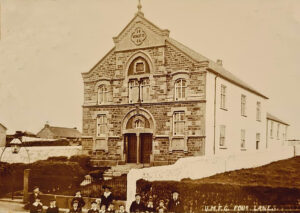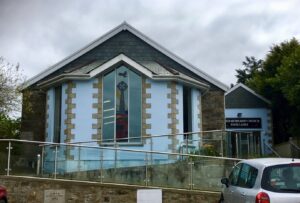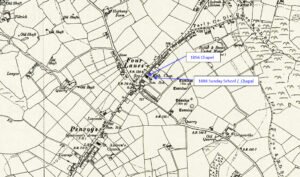This profile of Four Lanes UMFC has been compiled by Jo Lewis and Tony Masell.
Heritage Gateway: A United, later the Free United, Methodist chapel is recorded at this location in Four Lanes on the 1st and 2nd edition 1:2500 1880 and 1907 OS Maps. By 1907 a separate Sunday school had been constructed to the rear (south). Following the demolition of the original chapel the congregation has moved into the Sunday school, the Mastermap recording that building as the current chapel. https://www.heritagegateway.org.uk/Gateway/Results_Single.aspx?uid=MCO52195&resourceID=1020
Heritage Gateway: By 1907 the detached Sunday school to Four Lanes FreeUnited Methodist chapel had been constructed at this location and is recorded on the 2nd Edition1:2500 OS Map. On the current Mastermap the original chapel on the street frontage has been demolished and the Sunday school is now used as the chapel. https://www.heritagegateway.org.uk/Gateway/Results_Single.aspx?uid=MCO52196&resourceID=1020
[Davids Facebook commentary about the chapel
The dominant Nonconformist religious force in the village in the second half of the nineteenth century was Free Methodism, the United Methodist Free Church. The mainstream Wesleyans didn’t really get a look in within the village, the Anglican Church of which, St Andrew’s, Pencoys, leaned towards the Tractarian High Church party. Much smaller Wesleyan chapels existed on the western and eastern ends of the settlement at Forest and Wheal Buller respectively.
 The Free Methodists erected a substantial chapel on the southern side of the village main street with plain sides but a very elaborate and ornate facade in an Italianate style in 1856, which dominated the settlement. This picture is of around 1904 by the Illogan photographer E A Bragg and shows a complete view of the now vanished premises.
The Free Methodists erected a substantial chapel on the southern side of the village main street with plain sides but a very elaborate and ornate facade in an Italianate style in 1856, which dominated the settlement. This picture is of around 1904 by the Illogan photographer E A Bragg and shows a complete view of the now vanished premises.
 This postcard image shows the imposing interior of the building, taken by the Redruth photographer W J Caddy in about 1910. Note the large rostrum for preaching. Of particular interest is the Gothic cased organ, constructed by the Truro organ building firm of Heard, with beautifully colour stencilled organ pipes. The firm is known to have made two other organs with cases of this same design, both for Methodist chapels at Stithians Hendra Wesleyan chapel and Ponsanooth Wesleyan chapel, the Stithians organ ending up in the parish church there.
This postcard image shows the imposing interior of the building, taken by the Redruth photographer W J Caddy in about 1910. Note the large rostrum for preaching. Of particular interest is the Gothic cased organ, constructed by the Truro organ building firm of Heard, with beautifully colour stencilled organ pipes. The firm is known to have made two other organs with cases of this same design, both for Methodist chapels at Stithians Hendra Wesleyan chapel and Ponsanooth Wesleyan chapel, the Stithians organ ending up in the parish church there.
A Sunday School building was added on to the rear of the Chapel in 1884 and this can be seen in Bragg’s postcard view.
At Four Lanes the seat rent system lingered a little longer than some of the other local chapels who had given it up in the 1960s, being in use there until 1978.
The chapel archives at Kresen Kernow at Redruth contain a large memorial card to William Henry Richards who was for 20 years the Sunday School Superintendent, who died on 20 June 1891, aged 56 years. The chapel’s surviving baptism registers do not commence until 1906.
In the 1930s there appears to have been a rift in the Four Lanes Society, during the ministry of the Revd Frank Edgar Poad, a Devon man, who had been born at Plymouth in 1887 and had entered the ministry in 1911. Poad was very much in favour of following the policies and procedures of the governing Methodist Conference, with some supporters within the Four Lanes Society, but others were not of the same opinion. Matters came to a head when a number of members who were Poad supporters left the chapel and built their own small wooden chapel at Loscombe and worshipped there instead, having the nickname of Poadites. The remaining Methodists in the village continued to worship in the large 1856 building. The Revd Poad died at Nassau in the Bahamas on 18 September 1974.
Many years later the very exposed roof of the Chapel was very badly damaged by a storm, the village being probably one of the most windswept places in West Cornwall. Subsequent to this event the large chapel was completely demolished and its site became the car park for a revamped Four Lanes United Methodist Church, based around what was the former rear Sunday School building. The refurbished chapel was opened on 8 August 2009. The chapel’s demolition was a great architectural loss to the area]
1856 Four Lanes United Methodist Free Church
Built in1856 as a Free Methodist Church and shown on early maps.
1884: Sunday school added at the rear of the site.
The chapel was refurbished/rebuilt and reopened in 1906.
Cornish Memory also show a picture of the 1906 church re-opening ceremony (http://cornishmemory.com/item/BRA_4_069).
1907: The Methodist New Connexion, Bible Christians and United Methodist Free Churches amalgamated to become the United Methodist Church.
1907: The chapel became Four Lanes United Methodist Church.
1932: The Wesleyan, Primitive Methodist and the United Methodist Church amalgamated to become the Methodist Church of Great Britain.
1932: Became Four Lanes Methodist Church.
1930s: A rift in the congregation led to a breakaway group led by the Revd Fran Poad, and known as Poadites, who set up Loscombe chapel (http://cornishstory.com/2021/07/05/mapping-methodism-four-lanes-loscombe-methodist-chapel/)
1940: Seating for 356. (Revd David Easton)
1966: The 1856 chapel was damaged by a storm around.
1979: The 1856 chapel was demolished and the site used as a car park for the chapel / Sunday school at the rear of the site.
1979 Four Lanes Methodist Chapel
The 1884 Sunday school became Four Lanes Methodist Chapel.
2009: The building was extensively refurbished.
2009: Refurbished chapel re-opened.
 (Photo: Jo Lewis)
(Photo: Jo Lewis)
2024: the Four Lanes Methodist Church is still active.
Further reading:
https://methodist121.org.uk/chapels/four-lanes/
https://www.facebook.com/fourlanespencoys/
Kresen Kernow documents: https://kresenkernow.org/SOAP/search/RelatedNameCode.keyword/CRO%7CUK%7C625/
https://www.storylines.org.uk/2018/12/05/listening-to-chattering-starlings/

 Map:
Map: